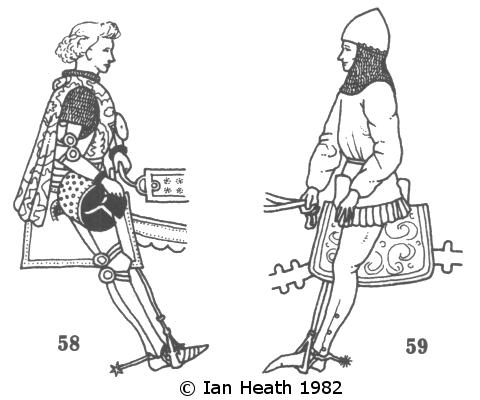|
|
PAGES
An extract from Armies of the Middle Ages, volume 1
by Ian Heath
58 & 59. PAGES
Because pages were children a mistaken belief has arisen among many modern authorities, including Ferdinand Lot, that they were non-combatants.
Certainly they were not soldiers in the same sense that men-at-arms, archers and pikemen were, but nor were they merely civilian onlookers.
French, Burgundian and English sources make it abundantly clear that the very least they were normally expected to do,
along with the other servants, was guard the army's camp, baggage or horses; Froissart, for instance,
describes how at Nogent-sur-Seine in 1359 the French men-at-arms 'went to the boys who were guarding the English horses and killed or
made prisoners the greater part of them'. On other occasions they took an even more active role,
one of their battlefield duties being to help their lord to his feet if he was knocked down,
and Froissart records that at Roosebeke 'as the Flemings were beaten down, there were (French)
pages ready to cut their throats with great knives'.
He also records an episode at Crécy in which Thierry de Senzeille's page, mounted on his spare horse,
followed him right through the English lines and rescued him when his own horse stumbled in a ditch.
In the Burgundian ordinance of 1471 the mounted page was expected to advance close behind the archers
with their horses once they had dismounted. The page was therefore in many respects clearly a combatant.
The figures illustrated here both date to the 15th century. 58 is from one of
Uccello's mid-century paintings of the Battle of San Romano
(see note 77) and depicts Tolentino's page,
wearing the same floral red and gold tabard as his master, behind whom he is depicted in the midst of battle.
The barbute he carries, covered in red velvet and gilt rivets, is undoubtedly Tolentino's.
His full plate-armour is highly unusual for a page, who was more usually almost completely unarmoured like figure 59 (from a Burgundian ms.).
Monstrelet speaks of pages along with 'others not able to defend themselves',
undoubtedly meaning that they lacked sufficient arms with which to do so effectively,
and other sources indicate that a helmet and a long dagger or short sword were usually the most that the page was likely to have.
In the original 59 is carrying his master's lance.
Next: 60 & 61. TRUMPETERS, in Armies of the Middle Ages, volume 1 by Ian Heath
See Italian Pages carrying their master's lance in Roman de Giron le Courtois
f. 33v,
f. 39v,
f. 45r,
f. 46r,
f. 47v,
f. 69r,
f. 76v.
|

